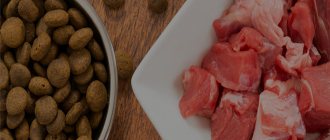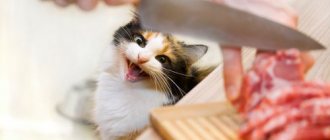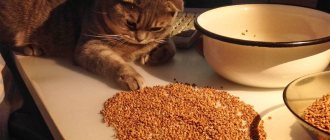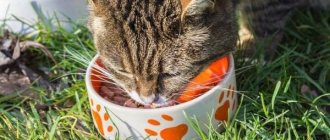Almost all cats love fish. Many of them, living in coastal regions, constantly eat seafood and feel great. There are even fishing cats from Southeast Asia and jungle cats that swim well and get their own food. However, our indoor pets are descendants of the steppe cat, which does not consume fish. Despite this, many of them receive fish as their main diet. Is it correct? Should fish be the mainstay of a cat's diet? If yes, which one? If not, what should you feed the animal instead of fish? And are there any restrictions regarding breeds? For example, can British and Scottish cats eat fish? You will get answers to these questions in the article.
This article is part of the Natural Cat Nutrition section.
The benefits of fish for cats
It is now fashionable to say that cats are absolutely not allowed to fish. But many continue to give it to their pet, rightly believing that thousands of cats have happily lived long lives on a fish diet. And it’s fair to say that such food has a number of advantages.
Complete set of amino acids
Fish is a complete protein of animal origin. It is easily digested in the short intestines of cats and contains essential amino acids, including taurine. Depending on the type of fish, the amount of protein is 16-24%, and it is absorbed by 95-98%, in contrast to meat protein - 87-90%.
Source of Omega-3 Fatty Acids
Unlike humans, it is not lean fish that is healthier for a cat, but fatty fish. In river fish (ruff, perch, pike) the fat content does not exceed 4%, the same amount in pollock, cod, and flounder. Noble varieties of fish contain 9-25% fat: herring, salmon, mackerel, sturgeon. Fat serves as a valuable source of energy and essential Omega-3 acids. Unsaturated fatty acids ensure healthy skin and coat, help reduce inflammation in the joints, and are necessary for the normal functioning of the heart and kidneys. If the cat does not get enough omega-3 acids from food, it is recommended to administer them in the form of dietary supplements (fish oil).
Thus, with fatty fish, the cat receives high-quality protein and the optimal amount of “good” fat. Claims that fish is not a species-specific food for cats are unsubstantiated. In the same way, it is not natural to feed your pet beef or chicken, because in nature a cat would eat a mouse or small bird whole, with head, skin, entrails and bones.
And what should I do with this fish?
Attractive taste and aroma
Many cats love the smell of fish and seafood. You can easily add vegetables to your pet’s food by grinding them together with fish, and even feed the tablet. Using fish juice, they flavor the water, stimulating the cat to drink more - this is necessary for diseases of the urinary system.
Even a small amount of fish in industrial food can make the product attractive to cats - this property has been successfully used, for example, in the production of “unpalatable” food for cats with kidney failure (Renal).
Fish...murrr
In other words, fish is a good way to pamper your cat, diversify the menu, and even encourage desirable behavior (training). But fish can bring not benefits, but great harm to health, if fed incorrectly.
Fish for kittens
The day you start, you need to make sure there are no allergies. It is best to introduce a new product during complementary feeding, when the baby has his first teeth. Do not rush to feed all sources of animal proteins at once and record the body's reaction.
Another important point is minimizing the risk of parasite infection. Before consuming fish products, the kitten must be dewormed.
It is also recommended to avoid varieties that are too fatty. Out of habit, they can cause stomach or intestinal upset.
What kind of fish is best to give to cats?
Let’s make a reservation right away - you should choose fish not for reasons of cheapness, but based on what kind of fish will benefit the cat.
Cats should not be given:
- Freshwater fish varieties (carp, roach, bream, crucian carp).
Cannot be fed raw due to the high content of antivitamins and deworming. And even when boiled, it is impossible to get rid of many small bones that are dangerous for your pet. The meat is too lean, there is not enough of it, and the labor costs for such food are not worth it - it is easier to give a piece of chicken.
Small fish caught with a fishing rod are not the best treat
- Sea fish that accumulate histamine and mercury (tuna, mackerel, herring).
The most useful varieties include fish from the salmon family:
- river trout (lives only in clean water, quite fatty, rarely infected with parasites);
- salmon, pink salmon, chum salmon.
If you need a diet with a low amount of fat, then you can give boiled lean fish - hake, cod, blue whiting.
Trout is a good choice
Nutrition for sterilized pets
Natural food is also beneficial for these pets. Can neutered cats be given raw meat? Yes, but you need to calculate the amount correctly.
Neutered animals are less active and more prone to obesity. They can be fed in smaller portions, focusing on lean meats and pureed boiled vegetables. It is also better to choose dairy products for sterilized cats with low fat content.
Regardless of the choice of food for your pet, the main thing is that he is cheerful and energetic, with shiny fur and a good appetite.
How to give fish to cats
More than half of the problems associated with feeding fish can be avoided by boiling the delicacy. When cooked, thiaminase (vitamin B1 antagonist) and trimethylamine oxide (iron antagonist) are destroyed, and parasite larvae are killed.
Before giving fish to a cat, you need to remove fins, bones, and all sharp parts of the carcass. It is not advisable to feed milk or heads separately; they give only meat.
Fish should not be the basis of the diet; it is better to give it as an additional source of valuable substances and delicacies. If your cat eats fish often, you need to take care of additionally including vitamins E, K, and group B in the food.
Fish is an excellent flavoring agent, so many owners use it to disguise cereals or vegetables - the fish is mixed with them in a bowl in the form of minced meat or small pieces.
Let's summarize. In order for fish to be beneficial and not harmful, you should:
- Choose a type of fish;
- Boil for at least 20 minutes (do not add salt to the water!);
- Remove bones (fillet);
- Give no more than 1-2 times a week;
- Make sure your cat is not allergic to fish.
It is strictly forbidden to feed your cat salted, dried, smoked, fried fish or canned food.
The owner needs to be careful that the cat does not develop a dependence on fish - when the pet refuses any other food.
Give me more fish, man!
What about dry fish food?
Let's consider the composition of high-quality feeds, in which fish is used as the main source of protein (in cheap feeds, fishmeal acts only as a flavoring agent).
- Acana Pacifica: used whole herring, sardine and flounder (whole carcass with bones and giblets), whole sea bass and hake, cod fillet. The fat content of the feed is 20%, the calcium to phosphorus ratio is 1.4:1, choline chloride (vitamin B4) and vitamins K and E are added additionally.
- Now Natural Fish Adult Recipe: component No. 1 of trout fillet, additionally enriched with many vitamins, minerals and individual amino acids. 19% fat, phosphorus content is significantly less than in Akan.
- Aatu Cat Salmon&Herring: salmon fillet and whole herring. Vitamins A, D, E, iron, zinc, manganese and amino acids – additionally. 18% fat, calcium to phosphorus 1.3:1.
These foods are safe for cats because:
- no injuries from fish bones;
- the fish has been heat-treated - there are no parasites or substances that destroy vitamins;
- the balance of calcium and phosphorus is maintained;
- a large amount of animal protein maintains the acidic environment of urine, which is the best prevention of urolithiasis;
- vitamins and microelements are added additionally or at the expense of other feed components.
The only threat that remains open is the toxins contained in marine fish. The mercury content in animal feed should be controlled, but it is difficult to say whether this is actually the case. Owners should avoid constant use of dry and wet tuna-based food, as it is the leader in the content of heavy metals.
Precautions and possible harm
The animal's love for this product does not allow it to control its quantity. The owner is responsible for the safety of the pet, so he should minimize harm from fish dishes.
Injuries (bones, gills, fins)
Bones can stick into the soft tissues of the oral cavity, causing inflammation. When they get stuck in the throat, they interfere with breathing, which, without timely help from a veterinarian, causes the death of the cat. Bones that damage the intestines cause internal bleeding, digestive disorders and the development of gastritis. To reduce the risk of injury, cats are given fillets.
Excess phosphorus
Wild animals eat fish with bones, receiving a balanced form of phosphorus and calcium. Pets eat only fillet, which results in an excess of the former and the development of urolithiasis. Using dry food or rarely including fish in the diet helps maintain balance.
Parasites
Freshwater fish can become a source of helminths that affect not only the intestines, but also the liver, kidneys, heart and brain. An infected animal's appetite worsens, problems with stool appear, and its coat becomes dull. In severe forms of the disease, the pet dies. Before feeding the animal, the fish is frozen or boiled.
If your pet experiences complications after eating fish, contact your veterinarian immediately.
Avitaminosis
The raw product contains an enzyme that destroys vitamin B, which, against the background of a low content of vitamins K, E and iron, provokes the development of subcutaneous inflammation and anemia with the frequent inclusion of fish dishes in the diet. With such a menu, the pet requires supplements to eliminate the deficiency of these substances.
Toxic substances
Regular consumption of tuna and salmon grown in Chinese waters, or pangasius from Indonesia can lead to:
- chronic poisoning;
- the appearance of malignant neoplasms;
- renal failure.
Long-lived fish accumulate pesticides, heavy metal salts, and poisons to which the cat’s body is sensitive. To reduce the risk of deterioration in the animal’s health, it is worth reducing the amount of such a product in its menu.
Hyperthyroidism
In older animals, hormonal levels change, which affects the functioning of the thyroid gland. Excessive intake of iodine into the body with frequent feeding of fish leads to the development of hyperthyroidism.











